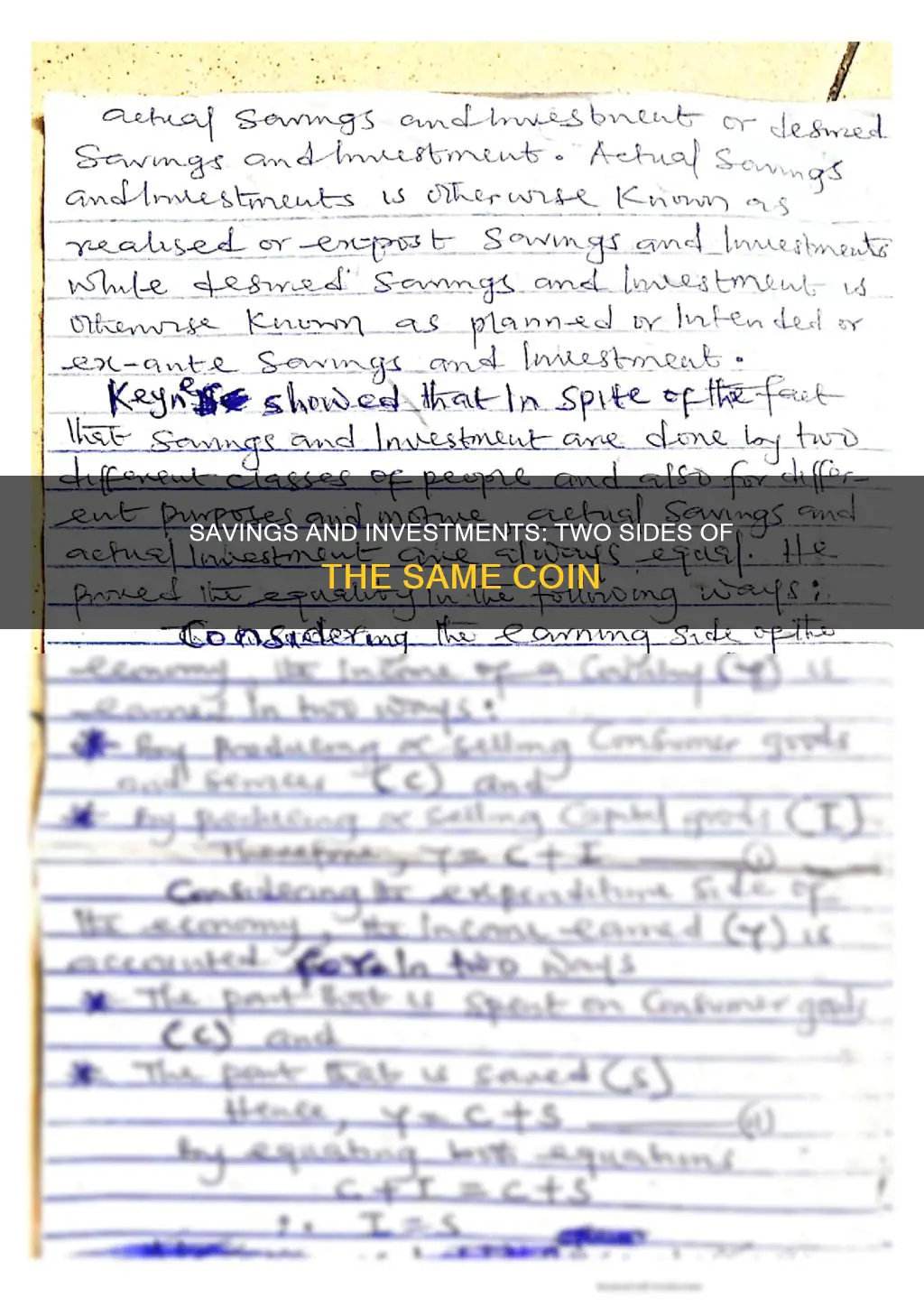
The concept of savings equalling investment is a crucial one in economics, specifically in national income accounting. In a closed economy, national savings (Y - C - G) equals investment (I), where Y is GDP, C is consumption, and G is government purchases. Private savings are calculated as (Y - C - T), while public savings are (T - G). In an open economy, net exports (NX) affect this relationship, with investment being financed by net capital inflow when imports exceed exports.
This is known as the saving identity or the saving-investment identity, and it is an identity, meaning it is true by definition. This identity only holds true because investment here is defined as including inventory accumulation, both deliberate and unintended. Thus, should consumers decide to save more and spend less, the fall in demand would lead to an increase in business inventories. The change in inventories brings saving and investment into balance without any intention by businesses to increase investment.
The saving-investment identity is often misunderstood. Many explanations are hampered by a lack of understanding of what an identity is. An identity is a mathematical fact that is true in any possible world, with any possible set of behaviours. For example, one incorrect explanation of the identity says that saving equals investment because any saving is automatically invested. However, this cannot be correct. Even if banks and investors operate according to particular behavioural rules in practice, an equation must be true for all possible sets of behaviours.
The saving-investment identity is based on the fact that if some amount of this period's output is not consumed, then the only other possibility is that it gets stored until (at least) the next period. That is, by definition, savings. But, in a closed economy, investment is also, by definition, the portion of output that is not consumed this period. Put the two things together, and you should see that savings equal investment.
| Characteristics | Values |
|---|---|
| Definition of Investment | Amount of goods saved for future use |
| Savings and Investment are the same concept | Savings does not necessarily need to be in the form of cash |
| Savings in an Open Economy | Private saving + Governmental saving + Foreign investment domestically |
| Savings in a Closed Economy | Y - C - G |
What You'll Learn
- Savings and investment are equal because they are two ways of describing the same thing
- In a closed economy, the remainder of aggregate output after subtracting consumption and government spending must equal investment
- In an open economy, private saving, public saving (budget surplus/public debt reduction) and foreign investment domestically must equal private physical investment
- In a closed economy, national savings (Y - C - G) equals investment (I)
- In an open economy, net exports (NX) affect the relationship between savings and investment

Savings and investment are equal because they are two ways of describing the same thing
In a closed economy, national savings (Y - C - G) equals investment (I), where Y is GDP, C is consumption, and G is government purchases. Private savings are calculated as (Y - C - T), while public savings are (T - G). In other words, the amount of income that households have left after paying for consumption and taxes, plus the amount of tax revenue the government has left after paying for its spending, equals the amount of current income that is not spent on consumption or government purchases and is instead invested in new physical machinery, inventories, and the like.
In an open economy, net exports (NX) affect this relationship, with investment being financed by net capital inflow when imports exceed exports. In this case, the national income identity is:
{\displaystyle Y=C+I+G+(X-M)}
Where (X-M) is the balance of trade (exports minus imports). Private saving is still
{\displaystyle S=Y-T-C}
So, combining these equations, we get:
{\displaystyle I+G+(X-M)=S+T\to I=\underbrace {S} _{\text{private saving}}+\underbrace {(T-G)} _{\text{public saving}}+\underbrace {(M-X)} _{\text{capital inflow}}}
Thus, in both closed and open economies, the amount saved is always equal to the amount invested, as they are two ways of describing the same thing.
It is important to note that this identity holds true because investment is defined to include inventory accumulation, both deliberate and unintended. For example, if consumers decide to save more and spend less, the fall in demand would lead to an increase in business inventories, bringing saving and investment into balance.
Additionally, saving is defined to include both private and public saving, with public saving being positive when there is a budget surplus (i.e. public debt reduction). Therefore, even if businesses respond to increased inventories by decreasing output and intended investment, the reduction in output will reduce income, forcing an unintended reduction in saving, thus keeping the saving-investment identity true.
It is also worth mentioning that this identity does not imply that an increase in saving must lead directly to an increase in investment. Even if the end result of a process is a lower level of investment, the saving-investment identity will nonetheless remain true at any given point in time.
Emergency Savings: Where to Invest for Peace of Mind
You may want to see also

In a closed economy, the remainder of aggregate output after subtracting consumption and government spending must equal investment
Y = C + I + G
Where Y is GDP, C is consumption, I is investment, and G is government spending.
Rearranging the equation to solve for investment, we get:
Y - C - G = I
This shows that the remainder of aggregate output (Y) after subtracting consumption (C) and government spending (G) must equal investment (I). This relationship is known as the savings-investment identity.
In a closed economy, national savings is equal to private savings plus public savings. Private savings are calculated as disposable income (Y - T - C) minus taxes (T), while public savings are calculated as tax revenue (T) minus government spending (G). Thus, national savings can be expressed as:
Y - C - G = I = (Y - T - C) + (T - G)
This equation demonstrates that in a closed economy, the remainder of aggregate output after subtracting consumption and government spending must equal investment, with national savings being comprised of both private and public savings.
Private Investment: When Planning Exceeds Saving
You may want to see also

In an open economy, private saving, public saving (budget surplus/public debt reduction) and foreign investment domestically must equal private physical investment
In an open economy, private saving, public saving (budget surplus/public debt reduction), and foreign investment domestically must equal private physical investment. This is known as the saving-investment identity or the national saving and investment identity.
In a closed economy, the formula is:
> Y = C + I + G
> I = Y - C - G
Therefore, the remainder of aggregate output (Y), after subtracting consumption by individuals (C) and government (G), must equal investment (I).
However, in an open economy, the formula is:
> Y = C + I + G + (X - M)
Where (X - M) is the balance of trade (exports minus imports).
So, in an open economy, the national income identity is:
> I + G + (X - M) = S + T
> I = S + (T - G) + (M - X)
Here, S is private saving, T is taxes, G is government spending, M is imports, X is exports, and I is investment.
This relationship is true as a matter of definition because, for the macro economy, the quantity supplied of financial capital must be equal to the quantity demanded.
The fundamental notion that the total quantity of financial capital demanded equals the total quantity supplied must always remain true. Domestic savings will always appear as part of the supply of financial capital, and domestic investment will always appear as part of the demand for financial capital.
However, certain components of the national savings and investment identity can switch between the supply and demand sides. For example, if a country is running a trade deficit, it means money from abroad is entering the country, and the government considers it part of the supply of financial capital.
The saving-investment identity is a concept in national income accounting. It is true by definition and only holds true because investment is defined as including inventory accumulation, both deliberate and unintended. If consumers decide to save more and spend less, the fall in demand would lead to an increase in business inventories. The change in inventories brings saving and investment into balance without any intention by the business to increase investment.
This does not imply that an increase in saving must lead directly to an increase in investment. Businesses may respond to increased inventories by decreasing output and intended investment. This reduction in output will reduce income, forcing an unintended reduction in saving.
Even if the end result of this process is a lower level of investment, it will nonetheless remain true at any given point in time that the saving-investment identity holds.
Retirement Planning: Understanding 401(k) Investment and Savings Plans
You may want to see also

In a closed economy, national savings (Y - C - G) equals investment (I)
In this context, national savings refer to the sum of private and public savings. Private savings are calculated as Y - C - T, where T represents taxes, while public savings are calculated as T - G. Thus, national savings can be expressed as the sum of private and public savings: Y - C - T + T - G = Y - C - G.
This relationship between savings and investment is a fundamental concept in economics, known as the saving-investment identity. It holds true because investment includes both deliberate and unintended inventory accumulation. For example, if consumers decide to save more and spend less, the resulting fall in demand would lead to an increase in business inventories, bringing savings and investment into balance.
It is important to note that this identity does not imply that an increase in savings will directly lead to an increase in investment. Businesses may respond to increased inventories by decreasing output and intended investment. Consequently, the reduction in output will lower income, leading to an unintended reduction in savings. Even if the end result is a lower level of investment, the saving-investment identity will remain true at any given point in time.
Investing My Daughter's Savings: Strategies for Long-Term Growth
You may want to see also

In an open economy, net exports (NX) affect the relationship between savings and investment
In a closed economy, the formula for GDP is Y = C + I + G. However, in an open economy, net exports (NX) must be taken into account, so the formula becomes Y = C + I + G + NX.
In an open economy, the relationship between savings and investment is affected by net exports (NX). This is because the open economy allows for trade with other countries, resulting in a flow of money and goods into and out of the domestic economy. Net exports represent the difference between exports and imports, and they can impact the level of savings and investment in the economy.
When a country exports more goods and services than it imports, it earns a surplus in net exports, which can lead to an increase in national savings. This is because the country is bringing in more revenue from exports than it is spending on imports, resulting in a positive trade balance. This surplus can then be invested back into the economy or used to increase savings.
On the other hand, if a country imports more than it exports, it incurs a trade deficit, which can reduce national savings. In this case, the country is spending more on imports than it is earning from exports, leading to a negative trade balance. This deficit may require the country to borrow from abroad to finance its imports, reducing the amount available for savings and investment.
Additionally, net exports can impact the investment decisions of firms within the economy. If a country has a trade surplus, firms may be more inclined to invest in expanding their production capacity or developing new products, as they can take advantage of the favourable trade conditions to increase their market share or enter new markets. Conversely, if a country has a trade deficit, firms may be more cautious about investing, as they may face challenges in competing with foreign producers or accessing necessary inputs for their production processes.
It is important to note that the relationship between net exports, savings, and investment is complex and can be influenced by various factors, such as exchange rates, government policies, and the economic conditions of trading partners. Additionally, the impact of net exports on savings and investment may vary depending on the size and structure of the economy in question.
Savings, Investment, and Productivity: The Interplay for Economic Growth
You may want to see also
Frequently asked questions
In a closed economy, investment is defined as the portion of output that is not consumed by private individuals or the government. Therefore, savings (the amount of money not spent by consumers) is assumed to be Y - C - G.
In a closed economy, savings and investment are equal because any amount of output that is not consumed in the current period will be stored until (at least) the next period. This stored output is, by definition, savings, and it is also a form of investment, as it is not consumed in the current period.
Financial investments are made by households and typically include stocks and bonds. Economic investments are made by firms to boost production capacity and include things like factories, machinery, and equipment that increase future output.
National savings is the sum of private and public savings. Private savings refer to the amount of income that households have left after paying for consumption and taxes. Public savings refer to the tax revenue the government has left after its spending.
In an open economy, the savings-investment identity is affected by net exports (NX). Investment is financed by national savings plus net capital inflow, which occurs when imports exceed exports. The equation becomes: Investment = National Savings + Net Capital Inflow.







